Angkor Wat
Cambodia Past and Present, Part One of a Two-Part Series
I stood in front of my desk, tugging at the bottom of the jacket of my new camouflage green safari suit. I turned towards the window to gain a nice reflection and ran the fingers of my right hand over the two buttoned shoulder flares, four front pockets, cuffed short sleeves, and round cut stiff collar. Twenty-two dollars never bought more, I thought as I brushed a little dandruff off my right shoulder and settled in behind my desk. Just then junior reporter entered my office from the newsroom.
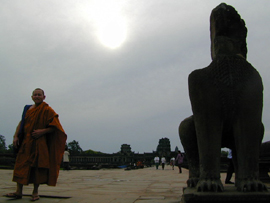 "Let me guess, Prime Minister Hun Sen is attending parliament meetings in his underwear now," she laughed.
"Let me guess, Prime Minister Hun Sen is attending parliament meetings in his underwear now," she laughed.
"As you obviously aren't aware, it pays to have a good tailor in Cambodia, my dear." I reached into my upper right pocket for my lighter.
"So what happened in Cambodia?" she asked.
While peeling the plastic from a fresh pack I replied, "Saw a little of the past, a little of the present..."
"Say wait a minute," she interrupted, "is that red lipstick on your upper left pocket?"
"Well, when we newsmen go out into the battlefield, there are certain hazards that go along with the profession." I stared straight at her. She folded her arms and frowned. I lit a smoke.
I awoke on my back at the edge of a large black pool of water; arms at my sides, legs and torso extending most of the way across a dusty red dirt path running along the pool, head twisted and precariously positioned in the short grass of the pool's bank with left ear flush to the ground. Mosquitoes danced in circles in front of my face. I hardly noticed though because two equally powerful forces were occupying what remained of my mind at the moment; gravity carrying me down the slight incline into the water and a week's worth of whiskey pressing on my forehead.
Out of the corner of my left eye, I spotted two Buddhist monks quietly walking on a stone bridge running perpendicular to the bank. I slowly panned outward from the saffron-robed figures to the center of the pool where I came upon the early morning reflections of three large darkened sandstone spires. A Phnom Penh gutter this was not.
"Get up, let's go!" she said. "I dragged your sorry corpse this far! You're gonna have to make it to the temples on your own!"
But before continuing, let's rewind a bit...
Now that Hollywood has closed its doors, Manhattan is my favorite disco in Phnom Penh. A large bar around one side, private karaoke rooms in the back, and a huge open dance floor filled with Vietnamese "taxi girls" - allegedly termed such because of the ease with which they can be picked up - out front.
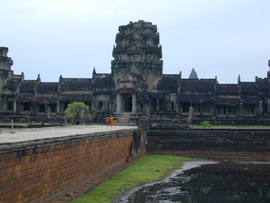 Noticing the smoothness of my moves on the floor, and perhaps the frequency with which I was throwing back the whiskeys, Hue approached in tight black jeans and equally tight black and red striped top.
Noticing the smoothness of my moves on the floor, and perhaps the frequency with which I was throwing back the whiskeys, Hue approached in tight black jeans and equally tight black and red striped top.
During a lull in a throbbing bass sequence, I leaned over and offered, "So why don't you and I escape to a better place - a place where we can strip ourselves of all this excess and experience real beauty?" She quickly nodded her approval. We went over to the bar for a final round. I threw back the glass. She followed and took my hand in leading the way out the door.
Outside two small and frail men on crutches immediately approached out of a crowd of milling girls and taxi drivers, whipping off their ball caps and holding them outward like baskets. When I shook my head, one firmly planted his crutches under his armpits and reached down with his right arm to remove his prosthetic leg. At that moment, the last slug of whiskey chose to strike. My eyes went skyward, my legs scissored, and my mind went blank. That was my last recollection until...
I staggered to my feet and we walked across the uneven stone bridge of the moat in the direction of the three large spires at the north gate of Angkor Thom, one of the largest temples at Angkor Wat, the 9th century monument in Siem Reap.
"Three years ago," Hue said, "there weren't many tourists visiting the temples. Today hotel rooms in Siem Reap go for between $100 and $300 and are sold out weeks in advance."
From the bridge, dense jungles can be seen encroaching on the large brick walls that flank either side of the spires and surround the ruins of the temple. Monks walk the grounds, staffs at hand, and satchels over their robes. On the roads outside, locals peddle souvenirs, drinks, and food to tourists.
I stood in the shadow of the middle spire, looking back across the bridge. "So what has happened in the last few years?"
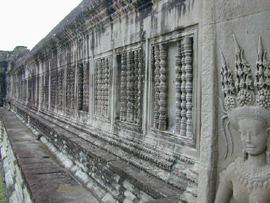 "For one, the Khmer Rouge days are over and most of the mines have been cleared. But the big reason is that this year Cambodia is to Hollywood what Tibet was a few years before."
"For one, the Khmer Rouge days are over and most of the mines have been cleared. But the big reason is that this year Cambodia is to Hollywood what Tibet was a few years before."
Last year Paramount Pictures arrived and over the course of five days filmed scenes for the upcoming blockbuster Tomb Raider. Angelina Jolie will run, jump, and swing through the ruins of the ancient capital as videogame heroine Lara Croft. Matt Dillon's Beneath the Banyan Tree and Oliver Stone's Beyond Borders will soon follow. Since the daily ticket price for entry to Angkor ($20) is equivalent to the monthly wage of a Cambodian school teacher, the Cambodian Government is hoping the anticipated hype will boost tourism to over a million people per year by 2003 and bring in badly needed money to a country still trying to recover from years of civil war. But will the dollars outweigh the damage the tourists may wreak on Angkor's treasures when they descend?
From the base of the spires, we stepped up to a magnificently filigreed arch leading to a chamber. Before entering the temple's large open central area, we passed two adjacent hallways joined by the chamber, their walls etched from end to end in intricate repeating reliefs of female dancers. All of Angkor's grounds encompass 200 km2 and one of most striking aspects of the temples, aside from their sheer size and beauty, is their accessibility. This open area is no exception.
"A thousand visitors a day come to see the temples," she said. "If more come, I can't imagine what this will be like." She held her arms outward, welcoming the sun that had now fully risen above the horizon. From our slightly tiered perch, we descended to a stone walkway splitting an open grass area surrounded by a large stone fence. Stone balustrades, the sharp grooves on their interior columns suggesting the work of a lathe (though the works are all handmade), extend the full length of the walkway
The only restricted areas within the ruins are those currently under restoration. Otherwise, tourists are free to walk along any walkway and up and down any set of stairs. Various international groups, including UNESCO, are currently engaged in projects to protect and study Angkor. A rather arduous task it is too.
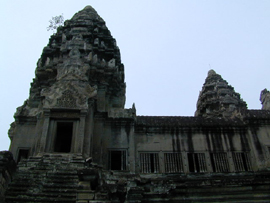 Wind, rain, various other elements, looters, and vandals have levied quite a toll over the past ten centuries, necessitating the reassembly of some artifacts and the preservation of others. At the edge of one of the large walls near the temple's moat, large interior wall segments have been painstakingly marked and cataloged and are in the process of being restored. Nearby the main bricks of the bridge crossing the moat are suffering from extreme subsidence. Within the temple nearly every statue and bust has some sort of patch or mend. And that is solely what can be restored. Further untold numbers of statues are missing. Others have been so badly damaged by vandals that restoration is not possible.
Wind, rain, various other elements, looters, and vandals have levied quite a toll over the past ten centuries, necessitating the reassembly of some artifacts and the preservation of others. At the edge of one of the large walls near the temple's moat, large interior wall segments have been painstakingly marked and cataloged and are in the process of being restored. Nearby the main bricks of the bridge crossing the moat are suffering from extreme subsidence. Within the temple nearly every statue and bust has some sort of patch or mend. And that is solely what can be restored. Further untold numbers of statues are missing. Others have been so badly damaged by vandals that restoration is not possible.
We crossed the open area to the opposite gate and turned to view the grounds. "We must remember that in restoring the past, it is important to look to the future," she said. "Future generations must respect this sacred place. I am not sure that Hollywood will help to do that."
"Yes but won't the incoming money allow for more restoration and preservation?" I asked, pointing to my left at a row of cobra statutes situated on a stone balustrade, each of their fanning necks split by at least one crack. Metal brackets supply support for the large sandstone pieces.
"Perhaps, but there is a chance that some damage could be irreparable," she paused when a monk passed in front of us and stopped. She continued, "All the restoration in the world might not replace some of these artifacts." She looked directly at a Khmer bust. The monk turned and smiled.
Junko stood in front of my desk admiring her Angkor Wat souvenir beach towel.
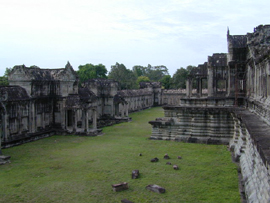 "So when you asked Hue to strip down of everything and show you real beauty," Junko asked, putting both her arms on my desk and leaning forward, "were the historic temples at Angkor exactly what you had in mind?"
"So when you asked Hue to strip down of everything and show you real beauty," Junko asked, putting both her arms on my desk and leaning forward, "were the historic temples at Angkor exactly what you had in mind?"
"Now Junko, I am shocked at your insinuation of her as anything other than a devoted student of archeology." I reached into my pack. I placed a single grit in my right hand and shook it up and down and said, "Besides, a newsman always knows what he is getting himself into." I put my feet on my desk.
After regaining her standing position near my desk, she began twisting the towel in her hands into the shape of an interior column of a balustrade.
"Actually," I said, lighting my smoke, "you'll be happy to know that that towel you have there is hot off the presses of a Phnom Penh garment factory."
Coming next week: A tour of a Cambodian garment factory

